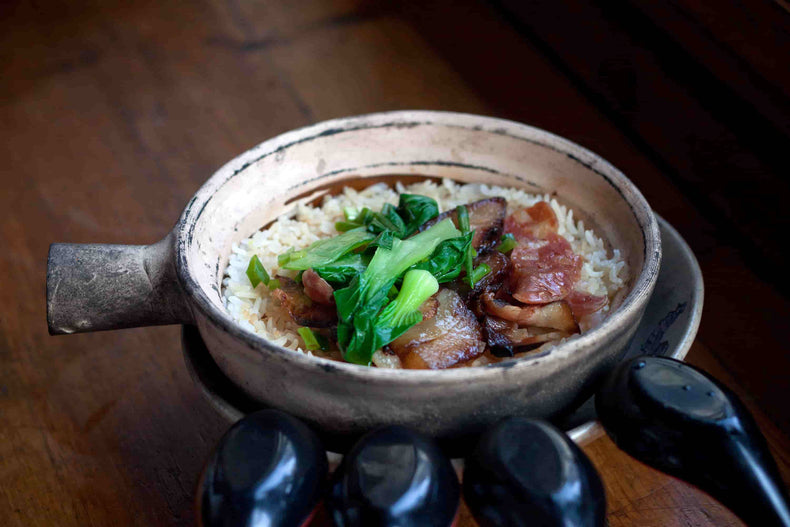What Is Chinese Sausage?
by Holly Thomson

Chinese sausage or wind-dried pork sausage (lap cheong or lạp xưởng), is a highly seasoned semi dried sausage, flavoured with rose. It is made from fatty pork, which gives it an incredibly rich flavour. Similar to a chorizo in appearance, it can be fried and served with wilted greens, steamed with rice, or minced and served in lettuce wraps.
Amy Poon, founder of Poon’s London and daughter of chef Bill Poon, explains what makes her family’s famous wind-dried sausages so special.
"My family has been making wind-dried meats since the early 1930s. My grandfather originally made sausages for his own consumption, out of a simple desire to make something he wanted to eat. Luckily for us, it turned out to be something that lots of people wanted to eat too.
"I remember my grandfather at his small factory in Hammersmith in the late seventies, wearing his wellies, rubber apron and hat – sitting at a workbench, preparing ducks under the harsh light of an anglepoise lamp.
"My father began making Poon’s wind-dried meats in London in 1970. Our wind-dried meats also became popular in Hong Kong and Macau, where my granny had restaurants.
"Today, we make five wind-dried products: Poon’s Wind-Dried Pork Sausages, Poon’s Wind-dried Pork & Duck Liver Sausages, Poon’s Wind-Dried Duck, Poon's Wind-Dried Bacon and Poon’s Wind-Dried Duck Gizzards.

Where do Chinese sausages come from?
"Our recipes are Cantonese in style. You will find that the different regions of China all have their own versions. In Sichuan for example, they add pepper and chilli to the sausage mix.
"My father’s family is from Shuntak, a city in Southern China which is widely recognised as the cradle of Cantonese cuisine on account of its geography, providing for outstanding produce.
"We use a rose liquor (Mei Kwei Lui) of exceptional quality, the fragrance of which really comes through.
How do you eat Chinese wind-dried sausage?
"My favourite way to eat our wind-dried meats is in a traditional Chinese claypot. This has been a signature dish on our menus since Poon’s opened in 1973 and proved to be very popular at the pop-up. Its beauty is in its simplicity.
There is an alchemy that occurs with clay and fire, and rice cooked this way has a particular fragrance and texture, not to mention taste.
You simply place the wind-dried meats on top of the rice as the water evaporates, cover with a lid and gradually turn down the heat.
The steam from the rice cooks the wind-dried meats gently and all the meat juices trickle through the rice, which forms a crispy base at the bottom of the claypot. It’s a magical dish and one which always brings me great comfort and satisfaction.
Other ways in which wind-dried sausages are often used are in ‘Lor Mai Gai’, sticky rice, wrapped in a lotus leaf and steamed, which you find on Dim Sum menus.

MORE: Explore our Chinese recipes for further inspiration
What do you eat Chinese sausage with?
Wind-dried sausages pair well with chicken and another popular dish is steamed chicken and Chinese mushrooms with wind-dried sausages.
One of our most popular dishes at Poon’s is ‘San Choi Bao’, minced pork and wind-dried bacon served in lettuce leaf wraps.
I encourage people to experiment with wind-dried sausages, treating them as you would cooking chorizo. I have, for example, served wind-dried sausages, sliced and simply sautéed with a splash of sherry as tapas which was delicious!
I have also used wind-dried sausages in stuffing, which adds a sweetness and depth to a traditional mix. Happy cooking and bon appetit!
Are Chinese sausages already cooked?
Chinese sausages are dried but not cooked, but should be cooked before eating.
Read Amy Poon’s guide to Chinese New Year here, or explore more Chinese products here.




